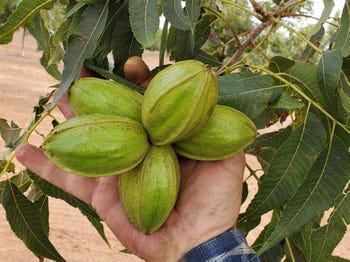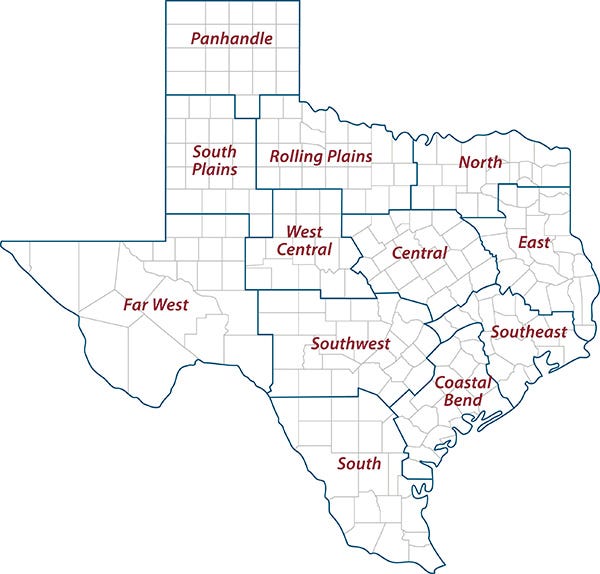
Texas pecan production appears better than expected, but market uncertainty amid the pandemic looms, said Texas A&M AgriLife Extension Service Horticulturist Larry Stein, Uvalde.
Expectations were for a below-average year, especially since 2019 production levels were above average, Stein said. Pecan tree performances are historically down following boon production seasons, he explained.
 (Pawnee pecan cluster in September prior to shuck split. Photo by Jake Montz)
(Pawnee pecan cluster in September prior to shuck split. Photo by Jake Montz)

Pecan producers have begun harvesting early varieties like Kanza and Pawnee. Harvest will ramp up going into October as later-maturing varieties are ready.
The Texas crop looks to be hit and miss, though some areas have a “heck of a crop,” Stein said. Drought and typical boon-to-bust production cycles contributed to lower quality and quantity in other areas around the state.
“Production results really have varied this year,” he said. “There were cyclical factors and weather and moisture conditions that all weighed into how growers fared this year.”
Conditions improve for pecan production
Rainfall and cooler temperatures are helping pecan orchards finish out, he said. Timely rainfall was especially important for growers in South and Central Texas.
“The rains are a big deal for those producers,” he said. “To get rain as kernels were filling, that will help with quality and quantity.”
El Paso pecan production was off last year and looks to be bouncing back with excellent yields and quality. On the other hand, an April freeze hurt pecan producers along the Red River, he said.
Major pecan production areas in southwest Texas, which rely on irrigation, were especially dry, he said, but now appear to be on track for a good year.
This season, Stein said trees seem to be cleaner with fewer honeydew aphids, black aphids, nut casebearer and webworms.
“There was very little pest pressure this year,” he said. “We don’t know why, but pecan casebearers weren’t that bad. Black aphids showed up late and weren’t bad. It seems to be a down year for pests.”
Improved management practices contributed to the better-than-expected performance overall, Stein said, but much of tree performance, insect and disease pressure remains in question.
The pecan market is uncertain for producers this year.
“Other fruits performed relatively well this year, despite a lot of questions going to market with COVID-19,” he said. “There were some struggles, but local sales of local food have been strong, so we could see the same thing with pecans.”
Pecan market uncertain
Catherine Clark, managing editor for Pecan South Magazine and the Texas Pecan Growers Association weekly marketing newsletter, said pecans have had a rough couple of years.
The pecan market changed dramatically around 2012 when Chinese demand for the nut began growing, she said. The demand for in-shell pecans direct from growers made prices climb until the trade dispute.
But the trade war with China hurt prices after tariffs increased from 7% to 40%, and COVID-19 added even more uncertainty to the 2020 pecan market, she said.
“The shutdowns in March and April at a time when harvests in South America and Australia were happening and shellers were trying to sell a larger-than-expected carryover supply has led to price drops and uncertainty going into harvest this season,” she said. “There’s not much buying activity or offers being made, but we are seeing some mom and pop retailers looking for pecan supplies so that they will have products going into the holidays.”
Clark said prices for in-shell pecans were $2 to $3 per pound, with shelled pecans around $4 per pound.
The U.S. Department of Agriculture will offer larger operations $40 million in buying contracts for pecan pieces that will go toward national food programs.
“It’s early in the season, so there is a lot of uncertainty,” she said. “Smaller operations might see some offers from nearby retailers, which historically give better prices to local growers, but movement has been slow so far.”
AgriLife Extension district reporters compiled the following summaries:

CENTRAL
Soil moisture levels improved dramatically over the last few weeks. Some areas received another 1.5-2 inches of rainfall. Temperatures were cooler. Some peanut producers anticipated they would begin digging in about a week. Producers were trying to get small grains planted. Pastures were experiencing good green-up, but fly numbers were up on cow herds. Some hay was baled where conditions were dry enough. Cotton, corn and sorghum harvests continued where possible. Cotton fields suffered from recent rains with lint being strung out, and the potential for discoloration, grade reductions and some seed sprouting issues. Stock tank levels were full and holding steady. Croplands were developing weeds and volunteer crops. There were some reports of fall armyworms.
ROLLING PLAINS
Cooler days helped maintain soil moisture. Wheat producers were planting in places with favorable soil conditions. Some areas were reporting signs of Alternaria leaf spots in cotton. Pastures and rangelands continued to improve.
COASTAL BEND
Some scattered rain fell throughout the reporting period, and Tropical Storm Beta was expected to bring more rain. Producers were hoping the rains would improve soil moisture conditions. Fieldwork was expected to be on hold for a few days as producers waited for conditions to dry. Cotton harvest was mostly complete with some harvesting slowed by wet conditions. Soil preparation and planting continued for winter pastures where producers were able. Pastures and ponds were expected to improve. Pecan yield potential looked good. Livestock were in good condition, and producers were starting to wean calves.
EAST
Scattered showers fell around the district. Some areas received rains and others stayed dry. Temperatures cooled a little. Pasture and rangeland conditions were good. Subsoil and topsoil conditions were adequate. Producers were trying to get a final cutting of hay or putting up hay. Others were preparing fields for winter pasture establishment. Livestock were in fair to good condition. Fly populations increased, and armyworms were reported. Wild pig activity remained high and damaged pastures, fields and other property.
SOUTH PLAINS
Very dry conditions continued. The pumpkin harvest was in full swing in Floyd County. Cotton fields have bolls. Rain was needed for planting winter wheat. Cattle were in good condition with supplemental feeding. Pastures needed moisture.
PANHANDLE
The district reported short to very short topsoil and subsoil moisture levels. Pasture and rangeland conditions were fair to very poor. Corn was in fair to good condition. Cotton and sorghum were in fair to poor condition. Soybean conditions were good to excellent. Wheat planting continued but was limited due to soil moisture levels.
NORTH
Soil moisture levels remained adequate to short for most counties. Rainfall was received in some areas. Cooler temperatures and mild winds made for good planting and harvest weather. Some managers looked to conduct late-season prescribed fires if the weather holds. Grain sorghum and soybeans were harvested. Pastures were in very good shape overall.
FAR WEST
Temperatures fluctuated with highs in the mid-90s and lows in the low 50s. Precipitation varied with some areas reporting trace amounts and other areas getting up to 6 inches. Areas that got the most rain have dried out enough to resume fieldwork. The sudden drop in temperatures and cold rain caused premature defoliation of cotton leaves. Most cotton fields suffered at least some level of damage and have stopped growing, and immature bolls were struggling to fill out. Several fields were ready to defoliate and were prepared for harvest. Small-acreage producers were breaking ground to plant winter wheat. Peanuts looked good. Rangelands and pastures improved but needed more rain. Weeds were emerging. Producers continued to feed livestock and wildlife.
WEST CENTRAL
Conditions dried enough to allow some fieldwork. Small grains were planted for winter grazing. Cotton harvest was finishing up. Pastures were greening up. Grasshoppers continued to plague pastures and were expected to hit emerged small grains. Livestock were in good condition heading into fall and winter.
SOUTHEAST
Scattered light rains helped moisture conditions. Grimes County reported good rains. Some producers were moving forward with cool-season forage plantings while others were holding off for additional moisture and possible reductions in fall armyworm activity. Fall garden activity was underway. Livestock were in good condition. Rangeland and pasture ratings were excellent to poor with good ratings being the most common. Soil moisture levels ranged from adequate to very short with adequate levels being the most common.
SOUTHWEST
Traces of precipitation up to three-quarters of an inch were reported across the district. Pasture and rangeland conditions were improving. Small-grain plantings were underway. Kendall County reported high prices and demand at the local cattle market. Livestock and wildlife were in fair condition and improving with supplemental feeding.
SOUTH
Northern parts of the district reported mild weather conditions with adequate soil moisture levels. Western, eastern and southern areas reported cooler temperatures, rainfall and short-to-adequate soil moisture levels. La Salle County reported heavy rains, and Live Oak County reported trace amounts of rain up to 2 inches. Some parts of Zapata County reported 3 inches of rainfall. Duvall County reported 3-5 inches of rain. Hidalgo County expected rains from Hurricane Beta, which was on track to make landfall north of the Rio Grande Valley. Jim Hogg County reported temperatures between 65-85 degrees. Cotton was complete in some areas and continued in others but was slowed in areas that received rain. The peanut crop continued to develop. Pasture and rangeland conditions continued to improve with recent rainfall. Stock tanks were replenished. Pecan orchards looked good. Some counties reported lush, green pastures. Some cantaloupes and watermelons were still being harvested. Ranchers were weaning and taking fall calves to market. Dove hunters were active. Hay producers reported a good season.
Source: is AgriLife TODAY, which is solely responsible for the information provided and is wholly owned by the source. Informa Business Media and all its subsidiaries are not responsible for any of the content contained in this information asset.
Read more about:
PecansAbout the Author(s)
You May Also Like




